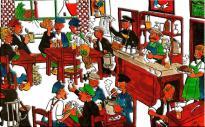L' histoire de Metz et de la Lorraine, histoire de la moselle - cartes postales anciennes de Metz - cartes postales anciennes de Moselle - histoire Moselle

Maison N°26, Rue Taison
Mr THIONVILLE J. Alexandre, a cabaretier by his trade, practised his art at number 26, rue Taison, in 1809. (Cabaretier is an old French word for bartender)
Under the Ancien Régime, there are almost as many drinks as they are places and ways to consume them! Cafe owner, limeade seller, bartender, taverner and street coffee seller are some of the multiple drink professions. However, there are some rules they have to follow. The drink professions
In the 17th century, several names
(limonadier (limeade seller), cabaretier, marchand de vin (wine merchant), crieur de café (street coffee seller), colporteur de tisane (street infusion seller)) refer to the profession as it is known nowadays. The limeade seller sells hot or cool drinks, alcohols and ices. Cabaretier refers to the tender of a cabaret à pot à pinte (meaning literally with pin pots) (where only drinks are served), or of a cabaret à pot et à assiette (meaning literally with pots and plates) (where drinks and food are served), or even of a simple cabaret (where one can also stay).
The one called wine merchant has no right to serve people in his shop, and bulk-sells or retails wine to go only. He is forbidden to practice his profession during religious services, on Sundays and holidays, after ten in the evening during the summer, and after eight in the evening during the winter.
Under the Ancien Régime, each city has its own street coffee (or infusion) seller, despite the objection of the café-limonadiers (bartenders-limeade sellers). The street coffee seller goes by in streets with a cafetiere with an imposing size. For two sols (an old French currency), he fills the cups handed to him with sugar-free coffee, milk serving as an accompaniment. As for the street infusion seller, he is, at the origin, a retailer of eau-de-vie, then a
merchant of aromatised liquorice-water, and finally a seller of a yellow solution called coco. With a hard hat or a three-cornered hat on his head, he carries on his back a big tin fountain covered with red velour and roams the streets shaking a small bell. He uses two tumblers linked to his belt by a small chain. He catches on most of all on partying days.
Coffee becomes fashionable
It is in 1654, in Marseilles, that coffee is served for the first time in an establishment that will be named after it. In Paris, the first cafe opens in 1671, in Saint-Germain-des-Prés. At that time, the beverage comes essentially from Saint-Domingue, Martinique or Guadeloupe. The republican wars and the loss of the colonies brutally make the prices rise under the French Revolution and, in order to keep their clientele, cafe owners mix the coffee with acorns, chestnuts, barley or rye. A bartender in Saint-Germain makes his fortune by using chicory roots for the first time. Beside the traditional beverages (wines, infusions, coffees), new drinks are created, notably liquors with surprising ingredients (pineapple alcohol, celery alcohol, clove cream, mint cream
) and with unlikely names (crème de macaroni, ratafia du Louvre, briolet d'Alsace, eau stomacale de l'électeur...).


